Nordic cuisine
Nordic cuisine
The cuisines of all Nordic countries are quite similar, although each country does have its signature dishes.
Countries and regions
Denmark is a major exporter of dairy products, pork and beer, and its cuisine has much in common with the German and Central European cuisine. Danes have a justified reputation of being more hedonistic than other Nordic people, eating greasy food, smoking, and enjoying more relaxed alcohol laws than further north.
Finland's cuisine has been influenced by Russian cuisine, with dishes such as meat pies (lihapiirakka), dark bread and, of course, vodka. They are the world's leading consumers of coffee and milk per capita.
Iceland is known for fish, lamb, and the more spectacular Þorramatur, a range of cured fish and meat products traditionally eaten during winter. Likely the most exotic of the Nordic cuisines, Iceland has dishes that not everyone may want to try, such as lamb's head and testicles, puffin meat and whale. The Faroe Islands have a cuisine rather similar to that of Iceland, except it is only the long-finned pilot whale (Globicephala melas) that is a local delicacy.
Norway also has a heritage of seafood. As with Iceland, Norway has a tradition of lamb dishes. Norwegians are said to eat more pizza per capita than people in any other country. Norway is one of the few countries in the world, where it is possible to eat whale at a restaurant.
Sweden, being the largest country in size and population, has at least one "signature dish" in all categories of food. Some delicacies are freshwater fish, crayfish, game, berries, and the iconic meatballs. Scania is Sweden's breadbasket and gateway to Denmark, famous for rich meat, poultry and bread dishes.
The cuisine of northern Scandinavia and the Sami people is based on the few ingredients available in the Arctic and sub-Arctic; predominantly reindeer, fish, and berries.
Understand
Before modern times, the majority of Nordic people had a very limited range of ingredients, especially in the far north. Famines occurred as recently as the 19th century. While industrialization came late, dining in the Nordic countries has become very cosmopolitan in the 21st century. In the 21st century, New Nordic or Modern Scandinavian cuisine has been taking the fine dining world by storm, by blending Nordic culinary traditions with influences from all over the world. Copenhagen and Stockholm are generally considered to be the main centres of New Nordic cuisine, featuring numerous Michelin-star restaurants and celebrity chefs, though there are numerous good options available in the other cities and increasingly rural areas as well.
Most traditional dishes are based on what used to be poor man's food, such as herring, dried fish, potatoes, and hard bread, although many have developed a certain refinement, are regarded national heritage, and variants are served also in classy context.
Ingredients
The world's stinkiest fish dish
Adventurous diners might want to try surströmming, which is Norrland's (northern Sweden's) entry in the revolting-foods-of-the-world contest. It's herring which is fermented in a tin can until the can starts to bulge and almost bursts. It all gets so foul-smelling that the fish is only eaten outdoors to keep it from stinking up the house, although it has been known for unsuspecting visitors from other countries to be "treated" to an indoor surströmming experience for more intensity. It is considered bad manners not to notify (or invite) the neighbors before having a surströmmingsskiva, a party where the delicacy is consumed. It is claimed that the best way to get over the smell is to take a deep breath of it just when you open the can, to as quickly as possible knock out your smelling sense. Surströmming is traditionally eaten in late August. Some restaurants, for obvious reasons not many, serve surströmming during these days.
It is considered bad manners not to notify (or invite) the neighbors before having a surströmmingsskiva, a party where the delicacy is consumed. It is claimed that the best way to get over the smell is to take a deep breath of it just when you open the can, to as quickly as possible knock out your smelling sense. Surströmming is traditionally eaten in late August. Some restaurants, for obvious reasons not many, serve surströmming during these days.
Seafood
With a long coastline, the fertile waters of the North Atlantic, and several lakes, fish and other seafood has a traditional role. The right to access and easily available permits allow leisure fishing to some extent in all Nordic countries, and most restaurant menus feature some kind of seafood.
- Pickled herring, (Clupea harengus, Danish/Norwegian: sild, Swedish: sill, Finnish: silli), used to be the poor man's dish, but has developed into a traditional appetizer, often in a few varieties (such as with mustard, garlic, tomato sauce or dill). Baltic herring, strömming, is the same species, though smaller, less fatty, and caught in the Baltic Sea. In Norway herring is also dried and smoked; the Norwegian sour herring should not be confused with surströmming, the Swedish fermented herring. In Denmark and Scania smoked herring (Danish: røget sild, Swedish: rökt sill) is available locally. Smoked herring from the island of Bornholm in the Baltic Sea are especially popular.
- Canned sardines in oil is a traditional Norwegian product (particularly in Stavanger that had a booming canning industry), but is actually made from local brisling (also known as skipper or sprat).
- Salmon (Salmo salar, lax/laks/lohi) is farmed in Norway, and used to be an everyday dish in northern Sweden, especially smoked or cured. Farmed salmon and rainbow trout have become the most common fish eaten in Finnish restaurants and non-fisher households. Smoked salmon, trout and other salmonid fish is served as everyday food in Norway, and can be fished with a rod. Hot and cold smoked are two variants. Cured salmon is known as gravlaks or gravlax. Fermented trout, rakfisk, is a smelly Norwegian speciality particularly produced and consumed in the interior valleys such as Valdres.
- Cod (Gadus morhua, torsk) is the most important catch in Norwegian waters. The winter-spring (February–April) catch of skrei (the migrating cod) has since prehistoric times been the high season for coastal areas. The fisheries around Lofoten are in particular unusually rich. Fresh skrei served lightly boiled is a standard dish during the season. In Lofoten and Nordland cod is also served with roe, liver and potatoes in dish known as mølje. The cod of the Baltic Sea has been overfished, and is vulnerable today.
- Wind-dried white fish such as cod tørrfisk (stockfish) is an ancient and important product of Northern Norway, used for lutefisk and other dishes. Salt-dried white fish klippfisk, an important product of western Norway, is used in similar ways.
- Freshwater and Baltic Sea fish, such as perch (Perca fluviatilis), pike and zander can be found at some restaurants and supermarkets, and is rather easy to fish with a rod.
- Roe (fish eggs) is a delicacy in Sweden. The roe from the vendace, Coregonus albula (siklöja in Swedish), known as löjrom, is among the most prized. Caviar in Nordic context usually refers to roe from the lumpfish, Cyclopterus lumpus (stenbit or sjurygg in Swedish, rognkjeks in Norwegian). Kaviar in Sweden and Norway refers to rendered fish roe with some additives, eaten as an everyday, relatively cheap, bread spread kept in "tubes".
- Cod liver oil (tran) is used as a dietary supplement particularly during winter for vitamin D. Bottles can be found on many breakfast buffets.
- The red king crab (Russian crab), Paralithodes camtschaticus, is native to the northern Pacific. Since the Soviets implanted the crab to the Barents Sea in the 1960s, it has become an invasive species spreading to Norwegian waters, becoming a new and popular ingredient.
- Crayfish (European or noble crayfish, Norwegian: kreps, Swedish: kräfta) is traditionally fished and eaten during August in Norway and Sweden, and among Swedish-speaking Finns. Kräftskiva is a traditional Swedish crayfish party.
- Norway lobster, sjøkreps ("sea crayfish"), Nephrops norvegicus, is a delicacy of the north Atlantic.
- European lobster, Homarus gammarus, is a culinary classic, very similar to the American lobster.
- Shrimp, especially Pandalus borealis (Norwegian: reker), have a prominent role in Norway, Denmark and western Sweden. Shrimp is harvested in fjords, along the coast and in the ocean. Shrimp is consumed in many variants. In summer many prefer to buy whole shrimp and have a party where each prepare their own shrimp at the table, often served with mayonnaise, lemon and white bread. Shrimp sandwich is a standard offer in Norwegian cafes.
- Clams and mussels are harvested and eaten, especially in Denmark. The blue or common mussel is widespread south of Trondheim, and is farmed commercially. Under certain conditions blue mussels may become toxic and amateurs should consult food authorities before harvesting.
- Whale has a peculiar taste, and can be found in Iceland and Norway. Whaling is a sensitive issue; see Animal ethics.
Meat

While whole meat remains a bit of a luxury, many traditional dishes are based on mince, offal and blood. Still, all countries have lively vegetarian and vegan communities, especially among young city-dwellers. Vegetarians face less understanding in the countryside, where hunting and fishing are popular pastimes.
- Pork is the most common meat, and one of Denmark's most important export commodities. Pork is used for sausages, meatballs, liver pâté and other meat products.
- While cattle are primarily held for milk, beef and veal are delicacies.
- Lamb is a signature dish of Iceland, the Faroe Islands and rural Norway. Several dishes are based on lamb, for instance "sheep's head" (Norwegian: smalahove), "sheep's ribs" (Norwegian: pinnekjøtt, ribbe) and fårikål (mutton stew with cabbage). Dried, salted and smoked meat products are common. In Western Norway lamb was traditionally the most common meat. There is a tradition of lamb dishes also in Finland.
- While chicken and other poultry became everyday food only in the late 20th century, goose is traditionally eaten in Denmark and southern Sweden. There are no strong traditions for poultry in the rest of the region, except wild ptarmigans (rype, ripa, kiiruna and riekko) hunted in the mountains and the north in the autumn.
- As hunting is a pastime in the countryside, game such as elk (moose), deer, boar, waterfowl and grouse is seasonally available, although mostly consumed in the hunters' households. A few restaurants offer game dishes.
- Reindeer are traditionally bred within the Sami culture in the Arctic and sub-Arctic territories. The meat tastes more like game than domestic animal meats. Reindeer meat might be served as whole meat, or as sautéed reindeer, (renskav in Swedish, finnbiff in Norwegian), traditionally eaten with potatoes and lingonberries.
Bread
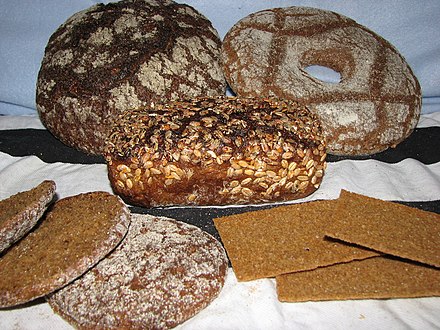

Bread (Swedish bröd, Danish/Norwegian brød, Icelandic: brauð, Finnish leipä) is a daily staple food.
Soft bread comes in dozens of varieties, with dark, heavy rye bread of different types common. Especially Finland, with influences from the east, has many types of traditional bread. For more taste, try to find bread from a local bakery, instead of packed bread in supermarkets. In Sweden many everyday breads are quite sweet, an acquired taste since the grain shortage during the war. Breads in supermarkets have also gradually become sweeter in Finland, where traditionally only some types were sweet, mostly through the use of malt. Another modern tendency is to add seeds and partly ground grain.
Potato is used in the rye based quite sweet perunalimppu (potatislimpa) found in most of Finland, and in some modern Finnish breads. It is also used in the soft flatbread perunarieska of northern Finland (supermarket "rieska" are usually modern variants). A similar but thinner, ubiquitous and inexpensive Norwegian bread, lompe, potetkake or potetlefse, is used for all kinds of a wrap, including for sausages (think hot dog) and rakfisk.
Hard flatbread or crisp bread (Norwegian: knekkebrød, Swedish: knäckebröd, Finnish: näkkileipä) are common, some served with cheese as dessert or snack, some worth tasting in their own right. Many locals appreciate them rather for their traditional value and shelf life than for their taste. There is also crisp bread made of wheat bread rolls (Swedish: skorpa, Finnish: korppu), some treated with cinnamon and sugar.
Iceland has a unique type of rye bread (rúgbrauð) that is baked by underground using the natural geothermal heat. It is typically sweeter than the rye breads that overseas visitors are used to.
Pastry
Scandinavian pastries are well known.
- The Danish pastry is called Wienerbrød ("Viennese bread"), since it was introduced by bakers from Vienna. Locals may reserve wienerbrød for specific variants of pastry, other variants in the vinnese tradition may have other names. Locals may be puzzled if you talk about pastry as "Danish".
- The cinnamon roll presumably originated in Sweden as kanelbulle (Norwegian: skillingsbolle), in Bergen it is believed to be invented there by the Hanseatic merchants.
- The semla (in Finland: laskiaispulla/fastlagsbulla) is a pastry eaten during lent in Sweden and Finland.
- Saffron buns are eaten for Christmas, traditionally on Saint Lucia's day in December; in Swedish the most prominent types are known as lussebulle or lussekatt.
- Cream cake (tårta in Swedish, bløktkake in Norwegian, lagkage in Danish, täytekakku in Finnish) is traditionally made of cream, sponge cake and wild berries. Often served for birthdays, particularly for children. Marzipan-covered variants are common in cafes and for celebrations.
- In Norway, Christmas is the traditional season for cookies and pastry, typically products that are easy to store dry for several months. It is said that every home should have at least 7 sorts for Christmas. Gingerbread cookies, often shaped as gingerbread men, is one of the most common type. Kransekake ("tower cake") made from almonds, sugar and egg white is also popular. In Western and Northern Norway lefse is usually made from wheat flour and served sweet with for instance brown cheese, sour cream, or sugar and cinnamon, a sweet lefse ready to eat can be up to 1 cm thick. Also lompe (see above) can be served sweet.
- In Norway, parties and formal dinners such as weddings often include a self-service kakebord ("cake buffet") with a wide selection of sweet pies and pastry for dessert and coffee. Traditionally guests bring one from each family as a gift and contribution to the party, and an opportunity to show off their baking skills.
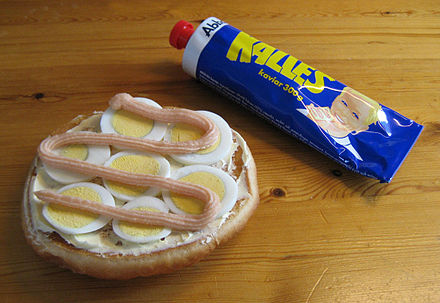
Milk and cheese
Milk and dairy products claim a large section of each supermarket, and are important ingredients in Nordic diets. Milk is consumed both as is ("sweet") and fermented ("sour"; Norwegian: surmelk, kulturmelk, kefir). Cream (Norwegian/Danish: fløte/fløde, Swedish: grädde) and sour cream (Norwegian: rømme, Swedish: gräddfil) are also widely used ingredients. Rømmegrøt, a porridge made from sour cream, is a Norwegian specialty. Buttermilk (Swedish: filmjölk) and "thick milk" (Norwegian: tjukkmjølk/tettmelk), are sour variants of yoghurt, another variant on the theme is filbunke or fil (Finnish: viili), common in Finland. Whey butter (Swedish: messmör, Norwegian: prim) and whey cheese (Swedish: mesost, Norwegian: brunost) are other typical Nordic products.
- The dominant type of cheese is hard cheese from cow milk as well as goat milk. Various traditional and novel cheeses are produced, increasingly on farms that sell the products themselves or through local groceries - some of which has won international recognition. Jarlsberg cheese is a world-wide brand of Norwegian white cheese.
- Gammelost ("old cheese") is a pungent and rich Norwegian special cheese made from skimmed, sour milk. Previously this cheese was produced on farms all around Western Norway, now the dairy in Vik at Sognefjord is the only place in the world where this unique cheese is made. The gammelost process is known at least since the Viking age. Pultost, produced in a similar process, is also unique to Norway.
- Brown cheese (Norwegian: brunost, geitost; Swedish: mesost), a Norwegian caramelised cheese made primarily from whey, is an iconic product of Norway. Brown cheese is also a product of some regions of Sweden such as Jämtland. There are many variants depending on the source of whey (milk from cow or goat), how much milk or cream is added in the process, and degree of caramelisation. Brown cheese made only from goat's milk may simply be called "real goat cheese". The softest type is also known as whey butter (Swedish: messmör, Norwegian: prim). Brown cheese is relatively sweet and often served with pastry or cookies for coffee.
- Skyr is an Icelandic dairy product, similar to yoghurt. It is traditionally eaten in a bowl with cold milk. Skyr originates from Norway, but the tradition died out in most of Scandinavia 1,100 years ago. Skyr is produced under an Icelandic licence in Norway, Sweden and Finland.
Mushrooms and vegetables
Wild mushrooms are picked and eaten in summer and autumn. This is however a recent tradition in most areas; Karl XIV Johan, a Napoleonic general, who ascended the throne of Sweden and Norway in 1814, is said to have introduced mushroom-eating to his new subjects. Since then, the porcini (Boletus edulis), one of the most popular mushrooms, is known as karljohan in Swedish. Eastern Finland had its own older tradition shared with the neighbouring regions in Russia, which has spread to most of the country. At restaurants you will mostly find chanterelles and cultivated button mushrooms. At open air markets in Finland, at least chanterelles and funnel chanterelles are available in season; some twenty more species were approved for sale before the market was deregulated and most of these appear at some markets from time to time, also other ones are often picked by experts. Commonly picked mushroom include Boletus, Russula and Lactarius species.
.jpg/440px-Cloudberries_(3804524774).jpg)
Traditional vegetables are those that thrive in the Nordic climate, such as cabbage, cauliflower, carrot and turnip (swede). Potatoes have been the main staple since the 19th century, most often simply boiled, but also made into mashed potatoes, baked, potato salad and more. The almond potato, puikula/mandelpotatis/mandelpotet, is a variety grown particularly at high altitudes or latitudes (because it is susceptible to plant diseases in the lowlands), a delicacy of Lapland, Norrland and Norway's high valleys such as Skjåk and Oppdal. It has a fine taste and texture, and is often served boiled for Christmas and with rakfisk or lutefisk.
While fresh fruit used to be a luxury until modern times, wild berries such as bilberry, lingonberry, cranberry, cloudberries and juniper berries are traditional condiments. Currants, raspberries, gooseberries and rhubarb, as well as apples and cherries, are widely grown both commercially and in private gardens. In Norway, apples and sweet cherries are grown in the fjord areas, notably Hardanger. Strawberries of fine quality are produced in large quantities during July and well into August in several areas.
Traditional spices are black pepper, juniper, dill and thyme, in low concentration. Salt has been widely used for conservation and features in many traditional meat and fish products. It was however rare in the northern regions, where food was traditionally dried, smoked or fermented instead. Naturally occurring herbs such as "forest garlic" (ramsløk) have been "rediscovered" and introduced in various products (such as cheese) and dishes.
Dishes
See also: Street food#Nordic countries
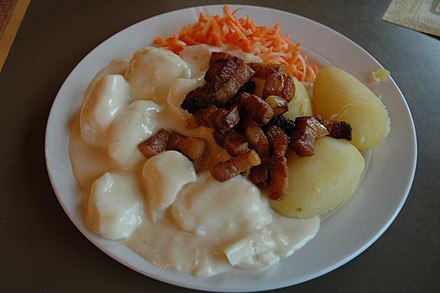
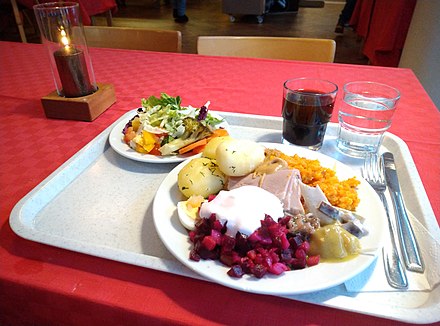
Famous pan-Scandinavian dishes include:
- Smörgåsbord (Danish: det store kolde bord, Norwegian: koldtbord, Finnish seisova pöytä or lounaspöytä), an extensive buffet with bread, herring, smoked fish, cold cuts, warm meats and desserts. Buffets are also popular for breakfast, lunch and dinner on Baltic Sea ferries, especially those between Finland, Sweden and Estonia.
- Husmanskost is a term for traditional, saturating but inexpensive food. While it is often used as everyday food in Nordic households, it is also commonly served at restaurants, some of which simply label their cuisine as "husmanskost". The last decades have seen a rise of a more modernized, gourmet style of husmanskost. In the simplest and most general terms, it consists of fried meat, boiled potatoes, and brown sauce, but many other dishes are possible.
- Meatballs (Swedish köttbullar, Norwegian kjøttkaker, Finnish lihapullia), served with potatoes, berries and creamy sauce (a certain furniture store largely popularized these outside of the Nordic countries)
- The falukorv is a sausage from Falun in Sweden. One of the most common ways of cooking it is sliced, fried and then served with ketchup and mashed potatoes.
- Medisterpølse is a sausage from Denmark. Traditionally served with boiled potatoes, dark gravy and mustard on the side. It also exists in Southern Sweden as medister, but the recipe is different with other spices.
- Pea soup (Swedish ärtsoppa, Finnish hernekeitto, Norwegian ertesuppe, Danish gule ærter), especially associated with Sweden and Finland where it's traditionally eaten on Thursdays and with pancakes and jam as dessert. It is also encountered in the other Nordic countries. There are many just-so-stories about the association to Thursdays; one of them tells that the servants had half the day off, and this is an easy meal to prepare.
- Lutefisk/lutfisk (Finnish: lipeäkala) is lye-processed dried white fish (stockfish or klippfisk), carefully warmed and served with potatoes, pea stew, bacon, and gravy. Drinks with lutefisk are typically beer and akvavit. Lutefisk is in many areas part of the Christmas tradition. Heated lutefisk emits an unpleasant odor; the taste is mild however.
- Open-face sandwiches are popular, especially the Danish and Norwegian smørrebrød/smørbrød. They can be small appetizers, or rich enough to make up a whole meal.
- Denmark, Sweden, Norway and Iceland each have their own national versions of the hot dog.
In the 21st century, there has been a focus on revitalising the "Nordic kitchen" by focusing on local produce and generally raising the quality of gastronomy in the region, often coined as Modern Scandinavian or New Nordic Cuisine. This is influencing both everyday cooking as well as fine dining. As a result, especially Copenhagen and Stockholm have seen the development of excellent high end restaurants, including NOMA, which has been awarded the best in the world 3 years in a row. Maaemo, Norway's equivalent to Noma, has been awarded 2 stars by Michelin and has also been listed among the world's top 100 restaurants. Dill in Reykjavik became the first Icelandic restaurant to gain a Michelin star in 2017. Palace in Helsinki, the first Finnish restaurant to get a star, got its second star in 2022.
Beverages
Nordic people are among the heaviest coffee drinkers in the world. Guests are typically invited for a cup of coffee and during a private visit in somebody's home guests will typically be offered coffee. In the Nordic countries, especially in Finland and Norway, coffee is generally more lightly roasted than in Central and Southern Europe. Drip brew (filter coffee) is the standard low price coffee, although cafes and coffee bars also offer a wide range of international styles. Boiled coffee is still used, particularly in the wilderness where electricity is not available. Tea and hot chocolate are usually available as alternatives to coffee.
- Julmust is a stout-like Christmas soft drink that every year annoys The Coca-Cola Company in Sweden by lowering Coke's sales figures by 50%. Available during Easter as well, by then known as Påskmust.
- Juleøl (Christmas beer), also known as nisseøl, is a type of white beer that was brewed in Denmark before the Pilsner type of beer was introduced in the second half of the 19. century. Juleøl has less than 2.25 % alcohol volume and is sweet and dark brewed on caramel and chocolate malt. Juleøl is served with risengrød or risalamande, traditional rice pudding dishes, the latter served at Christmas. It can also be served with smørrebrød.
- Svagdricka (weak drink) is a sweet low-alcohol beverage from Sweden that resembles the Danish juleøl. It is traditionally consumed around Christmas and Easter with traditional Swedish food. The few breweries left that produce svagdricka uses saccharin as an ingredient – an artificial sweetener. In Finland, the equivalent kotikalja is more widely available throughout the year, often an alternative at lunch in cafeterias.
Common beverages at lunch include milk, buttermilk and svagdricka. Some prefer mineral water or just plain water. Beer has also been common, but in the working day alcohol is avoided.
Tap water is generally of high quality (except some islands and mountain resorts), but many brands of bottled water (with or without gas) are available in shops and cafes. Some special types of mineral water have a higher content of salts and minerals, while many "health consciously" lack sodium altogether (check in hot weather!).
Sweet, carbonated soft drinks (Norwegian: brus) are common and available everywhere. Juices and sweetened soft drinks based on local berries, saft, are popular. While many berries have a strong taste and juices from them are always drunk diluted, many berry based drinks (saftdryck) just have traces of the nominal ingredient, especially those with synthetic flavouring.
Alcohol

Traditional Nordic drinking culture is double-natured; even one glass is taboo before work or driving, but binge drinking is accepted on weekends and holidays. By the 21th century, habits have become more continental, with more drinking during weekday nights. Drinking alcohol is still a sensitive issue for many people. Guests, particularly strangers, are customarily offered coffee rather than alcoholic drinks. Even some formal parties such as weddings are without alcohol for instance among people affiliated with the Christian temperance movement.
Alcohol laws used to be harsh in the early 20th century, with total prohibition for some time in Norway, Finland and Iceland. Restrictions have been softened over time; nowadays licence to serve beer and wine is quite easy to get.
Denmark stands out from the traditional Nordic drinking culture with a more casual attitude, similar to Central Europe. In Denmark it is not uncommon to see people of any adult age sitting outside in public, when weather allows, and sip a beer from the bottle. When as a guest you are offered a beer, it is still okay to prefer something else or decline. Generally, it is no longer accepted to consume any form of alcohol at the workplace, except when the management has approved of or provided an invitation to a social activity where alcohol is served. Pilsner beer from a keg is the norm, perhaps some wine for those who do not like beer – never hard liquor. It is expected that no one gets drunk and everybody act in a responsible way, otherwise their career is in jeopardy.
With the exception of Denmark, the Nordic countries regulate and tax alcohol harder than any other European country. Elsewhere, strong alcohol (wine, spirits and strong beer) is not available in grocery shops, only government outlets Vinmonopolet in Norway, Alko in Finland, Systembolaget in Sweden, Vínbúð on Iceland and Rúsdrekkasøla Landsins on the Faroe Islands. Therefore many Nordic people take advantage of the "cheap" booze when abroad (bordershopping), with places close to the border or easily reachable by ferry, for example in Germany, or Estonia, being frequent destinations for border tourism. Drinking in public outside of licensed premises is largely unheard of and even illegal; where alcohol is consumed in restaurants and pubs or in a private environment.
The main alcoholic beverages are beer and vodka-like distilled spirits called brännvin/brennivín, including herb-flavored akvavit (Norwegian: akevitt). Akvavit is traditionally produced from potatoes. The "line akvavit" is a variant that has been stored in oak barrels and crossed the equator line twice. Spirits are typically drunk as snaps or ice-cold from shot glasses. Wine is typically drunk in fine-dining contexts.
While Nordic wine production is more or less experimental, stores and restaurants provide wines from around the world. As the government stores are bulk buyers, a bottle of high-end wine can surprisingly cost less in Sweden or Finland than in the country of origin. A bottle of regular wine costs €8–12 (more in Norway); low-quality wines don't make it to the shelf.
Beer is a staple drink in restaurants and bars. Pils or pilsner, the light, pale lager beer, is the most widespread type of beer, often brewed to 4.5% (or the highest allowed alcohol content to be allowed in regular shops). Stronger beer is available in the above-mentioned monopoly stores or on licensed premises. Increasingly a wider selection of beer types, including local microbrews and exotic imports, are available in shops and bars.
Mead (mjöd) is an ancient fermented beverage made from honey, associated with the Viking Age. While not an everyday drink, and hard to find outside history-themed venues, it is an icon of Nordic culture. In Finland, mead (sima) is mostly associated with Walpurgis and May Day and it usually contains little or no alcohol.
Punsch (known as punssi in Finnish) is a traditional sweet liqueur (not generic punch) made from a combination of water, lemon, sugar, spirits and arrack, unique for Sweden and Finland. It can be served both warm and cold, usually has 25% alcohol by volume (ABV) and 30% sugar, and is by tradition often served on Thursdays together with pea & pork soup and pancakes – or to the coffee at the end of the meal at a student sitz or formal dinner. It grew very popular during the 18th and 19th centuries, generating a strong punsch-culture with numerous special punsch drinking songs, and maintains a strong presence in student culture.
Meals

Lunch style varies. While Norwegians typically eat a light lunch at work/school with a few slices of bread (niste) and perhaps salad, Swedes and Finns usually have a hot meal.
Dinner is usually the heaviest meal of the day. Typically eaten or served from 17:00 or later. In the countryside some still practice the tradition of eating dinner at noon, the word for dinner in Norwegian and Swedish is accordingly middag (literally mid day).
Light meals usually consist of coffee with a sandwich or a pastry. In Sweden, they are referred to as fika. Offices usually have a daily coffee break around 14:00 or 15:00, in Finland also at 09:00.
Restaurants
Not all Nordic restaurants serve Nordic cuisine. International trends have been incorporated in the Nordic cuisine, but many restaurants also feature dishes with few Nordic characteristics. There are also many restaurants with a non-domestic menu, often run by immigrants.
However, Nordic cuisine is available in the majority of restaurants.
Nordic countries are rather expensive for eating and drinking out, due to high wages and taxes. Unlike, say, the Mediterranean countries, dining out is something locals don't do every week. Self-catering and home cooking are the norm. On workdays, however, it is common to eat lunch at a restaurant, and such lunches can be had for a reasonable price. For instance, the all-you-can-eat "lunch table" buffet, which many cafés and restaurants in Finland offer, typically consists of a couple of salads and bread, 2–3 warm dishes, some type of dessert, plus water, milk or kotikalja (what Russians know as kvass) and coffee or tea — for around €10. Also, fast food restaurants and restaurants serving styles from outside the Nordic countries, Thailand and India for instance, offer more affordable deals. Norwegians usually eat a light packed lunch instead, and lunch offers in ordinary cafés and restaurants are limited. On the other hand Norwegian business hotels often offer hearty lunch buffets.
Tipping is welcome, particularly in full-service restaurants, but generally not expected. The exception is Iceland where, similar to some East Asian countries, tipping is never done.
Pubs and bars are about as common as further south in Europe, but do prepare to shell out more for your pint, especially in Norway and Iceland. In contrast to the rest of Europe, not all restaurants serve alcohol.
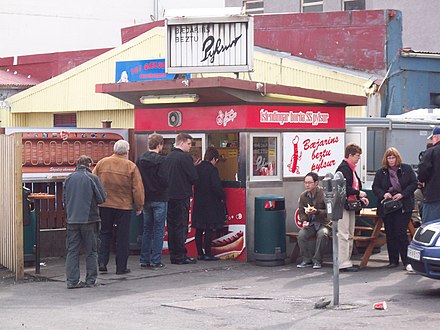
Street food is less common than for instance in East Asia. In the Nordic countries street food is found mostly in terms of sausage stands, Denmark has many traditional pølsebod whereas in Norway there are few left. At Christmas markets, Saturday "farmers' market" or festivals there may be a wider selection of street food.
The international furniture chain IKEA promotes its Swedish roots by serving Nordic meals far below market price. Foreign IKEA stores also sell Swedish retail food.
As in most of Europe, internationalised cuisines from around the world are popular in major Nordic cities. Especially Denmark and Sweden have many Middle Eastern, Thai, Chinese and South Asian restaurants, usually with genuine staff from said cultures. Norway has a large number of Asian cafés and restaurants.
Nordic people also have a fascination for sushi, as well as Italian and Tex-Mex cuisine; though many restaurants are far from authentic.
There are some unique combinations of international food, such as kebab pizza, in Sweden. Especially in Norrland, they can be more outlandish, such as Calskrove (a hamburger with French fries inside a Calzone).
Foraging, fishing and hunting
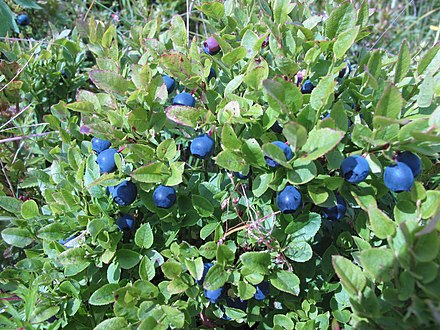
See also: Right to access
Picking berries, picking mushrooms, fishing and hunting are quite common pastimes in the Nordic countries, and the first three are easily available also to foreigners.
There is suitable land for picking berries and mushrooms nearly everywhere and such foraging is allowed by the right to access (with a few restrictions). You might want to be respectful and don't forage near other's houses, where they are likely to want to pick them themselves. If self-catering, fresh bilberries will do wonders to your morning porridge, a bilberry pie is easy to make, raspberries with whipped cream are an easy desert – and stopping for a moment on your wood-walk to pick and eat is one of the joys of the Nordic summer.
Some fishing is included in the right to access, while a permit for other lure fishing is mostly easy to buy. Check details, such as species and size limits, when you know where you are going. General fishing rights belong to the owner of the waters, and countryside dwellers often have a share, like some of their descendants. Thus you might have a chance to join your host or a friend laying and checking fishing nets or crayfish traps; self-caught fish is common on many dinner tables. Seine fishing under the ice is often a social event, where you could join, mostly as spectator, and get as much fish you ever wanted.
Hunting rights similarly belong to the land owner. Here the rights are usually given to the local hunting club, so any member – again many of the countryside dwellers – might be able to go on a hunting tour with you. Some tourist entrepreneurs keep their rights for themselves and their guests. Most big game requires specific permit acquired by the hunting club, but you might be able to join a hunt for licensed game; big game hunting is often a social event. For some game it is also possible to get a permit for a few days on government owned ground, in Finland typically hare or grouse in the designated wilderness areas. In addition to the hunting permit, each hunter needs a firearms licence if applicable, and a hunting license, in some cases including a test shooting. Joining or assisting a hunter does not require any licences, what such company is allowed to do may vary.
.JPG/440px-Kauppatori_Market_(3).JPG)